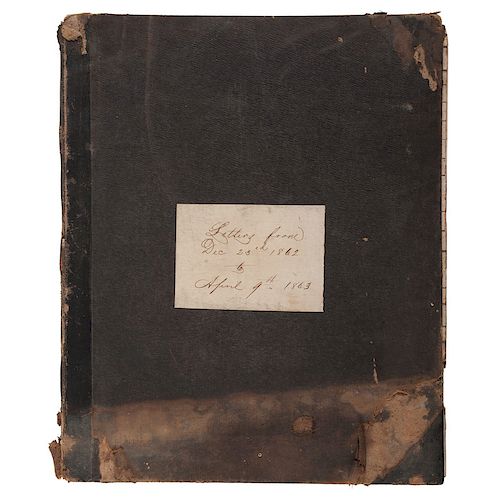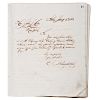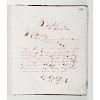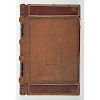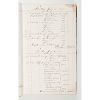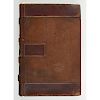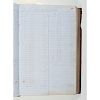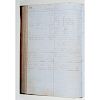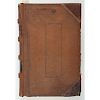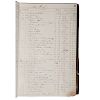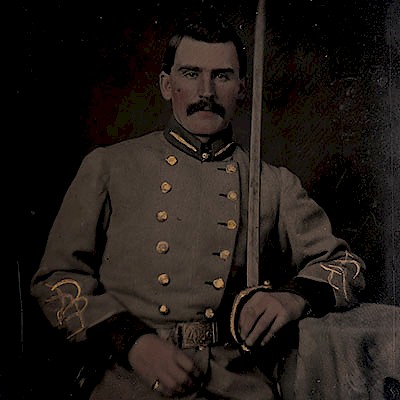Remington/Ilion Bank, New York, Founded by Eliphalet Remington, Collection of Early Ledgers, Journals, and Bank Letters
About Seller
6270 Este Ave.
Cincinnati , OH 45232
United States
With offices in Cincinnati, Cleveland and Denver, Cowan’s holds over 40 auctions each year, with annual sales exceeding $16M. We reach buyers around the globe, and take pride in our reputation for integrity, customer service and great results. A full-service house, Cowan’s Auctions specializes in Am...Read more
Two ways to bid:
- Leave a max absentee bid and the platform will bid on your behalf up to your maximum bid during the live auction.
- Bid live during the auction and your bids will be submitted real-time to the auctioneer.
Bid Increments
| Price | Bid Increment |
|---|---|
| $0 | $25 |
| $500 | $50 |
| $1,000 | $100 |
| $2,000 | $250 |
| $5,000 | $500 |
| $10,000 | $1,000 |
| $20,000 | $2,500 |
| $50,000 | $5,000 |
| $100,000 | $10,000 |
About Auction
Jun 22, 2018
Cowan’s American History: Premier Auction, scheduled for June 22, 2018 is comprised of early photographs, documents, manuscripts, broadsides, flags, and more dating from the Revolutionary War, the Civil War, Late Indian Wars, World War I and II and beyond. Cowan's Auctions dawnie@cowans.com
- Lot Description
Lot featuring 10 ledgers for the Ilion Bank, Herkimer Co., New York. A few of the leading citizens of Ilion Village got together in 1852 and organized the Ilion bank, which began operations on February 2, 1852 with a capital of $100,000. Eliphalet Remington was elected President and remained in that office until his death in 1861. He was succeeded by George Tuckerman. The first board of directors consisted of Remington, Samuel Cary (first VP), Benjamin Carver, John A. Rasbach, Jedediah P. Sill, John Ingersol, Lawrence L. Merry, William W. Sweeney, David R. Carrier, Dean Burgess, and Benjamin P. Markham. Robert Pomeroy was the first cashier.
Ilion Bank ceased operations in 1866, with all of its liabilities paid. On March 14, 1867, it began operation as Ilion National Bank, with Jacob J. Folts as the first president and Charles Harter as the first Cashier. Philo Remington, one of Eliphalet's three sons (the others being Samuel and Eliphalet III), succeeded Folts as president. One of the members of the INB board was Floyd C. Shephard, in 1862-63 the Ilion Bank's cashier.
Eliphalet Remington (1793-1861) was the second of that name, learning the blacksmith's trade by working with his father. When he wanted items which were out of his financial range, the younger Remington learned how to make them. One of his earliest was learning to make silver spoons for a sister's wedding. When he wanted a hunting rifle but could not afford one, he made one from scrap iron in the family forge. The rifle turned out to be of such high quality, that folks from all around placed orders for the firearms. Remington purchased land close to the Erie Canal, by way of which most of their orders were being shipped, and with financial backing from friends, set up a new forge and shop. (Unfortunately, the senior Remington was killed in an accident moving equipment to this new location.) Business grew steadily as Remington's rifles gained a reputation for quality craftsmanship and precision, and the next generation joined in, creating E. Remington and Sons.
The company landed its first government contract in 1845. In the 1850s, they began to design and manufacture revolvers. The company grew rapidly during the Civil War, producing nearly $3 million worth of rifles. Orders continued after the war, in part because of the demand for the new breach-loading design. But gradually, orders declined and Remington experimented with many other products, including streetcars and canal boats, velocipedes (bicycles), sewing machines, typewriters, farm implements and many more (such as cigar-making machines). The company encouraged invention, but it did not translate to financial success, and the company went bankrupt in 1886. It sold off many of its non-firearms divisions, but kept the typewriter division.
Like many other companies, it flourished during the Spanish-American War and World War I, but suffered during the Great Depression. But the company streamlined again and was poised for success during the second World War.
These books focus on the Ilion Bank, not technically part of E. Remington & Sons, but a business in which there was a large family stake. This lot covers the bank from the first year, about August 1852, until late 1858. The exception is a book of copies of letters from late 1862 to April 1863. The copy appears to have been made by a wet-transfer process and as a result the text is somewhat broke, blurred, etc.



 EUR
EUR CAD
CAD AUD
AUD GBP
GBP MXN
MXN HKD
HKD CNY
CNY MYR
MYR SEK
SEK SGD
SGD CHF
CHF THB
THB